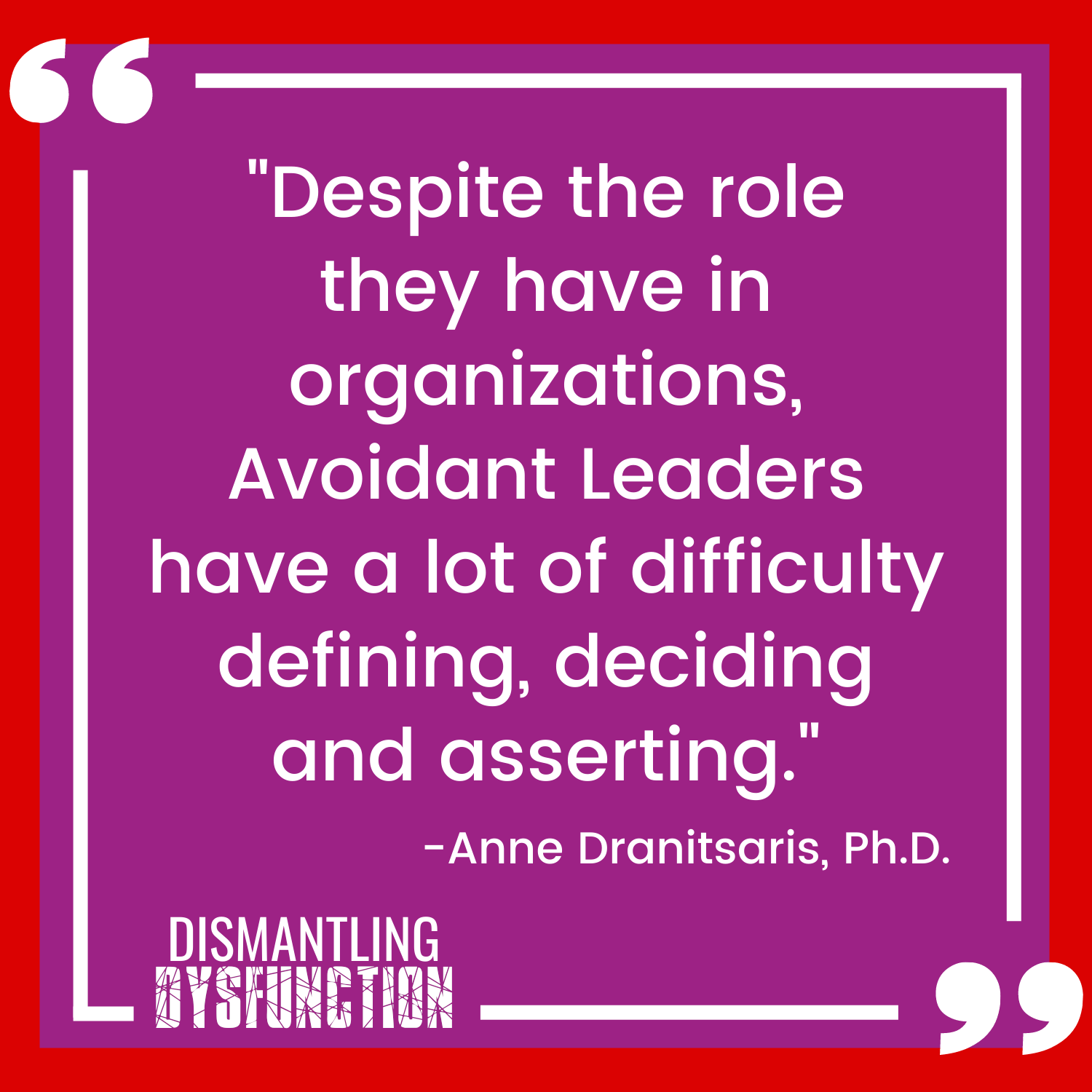Episode #14: Dysfunctions of Avoidant Leadership
Why do leaders believe that giving employees the freedom to do things their own way is so important to employee retention and engagement? Curious, isn’t it? And we wonder why employee entitlement is on the rise… So, if it’s not helping anyone, why is this destructive belief so appealing to so many leaders? While it may be influenced by the trend in leadership to leave employees alone to figure things out for themselves, we found it’s mostly caused by a passive, avoidant approach that’s driven by leaders’ fear of their own leadership authority. These leaders operate from a pervasive pattern of avoidance as it meets their need to focus on what they like to do, so they never have to feel uncomfortable by developing conscious leadership skills. They demonstrate a passive indifference about productivity, performance, and engagement, ignoring employees’ needs and issues. In fact, recent studies suggest that Avoidant Leaders and their practices lead to underperformance because they encourage carelessness and rule breaking. Ignoring employees’ desirable or undesirable behaviors without supportive or corrective responses is at the heart of the Avoidant Leadership Dysfunction.
In today’s episode, Anne & Heather explore the Dysfunctions of Avoidant Leadership and share some real client stories that illustrate just how common it is to find this type of leadership behavior in organizations today. They’ll also share some practical tips that you can use if the Avoidant Leadership Dysfunction is causing your leaders to fear their own authority.
If you want to know more about Anne & Heather’s work with dismantling dysfunctions in organizations and leadership behavior at Caliber Leadership Systems, check out:
https://dismantlingdysfunction.com
https://www.dranitsaris-hilliard.com
Stop contributing to organizational dysfunction. Pick up your copy of So, You Think You Can Lead?: A Guide to Developing Your Leadership Authority and Potential
Make sure you sign up for our weekly newsletters for tips on how to dismantle dysfunction and develop your leaders: https://bit.ly/dismantlingdysfunction
Are you dealing with an organizational dysfunction you need help with? Or do you have a story you would like to share on our show? Contact us at [email protected].
IN THIS EPISODE:
- [01:48] Episode introduction and overview
- [02:32] The four dysfunctional leadership styles
- [03:23] What is the Avoidant Leadership Dysfunction?
- [20:57] Two “settings” of the Avoidant Leader
- [24:09] Managing Avoidant direct reports
- [25:51] Dysfunctions that Avoidant Leaders can cause: Power Vacuum
- [28:36] Dysfunctions that Avoidant Leaders can cause: Indecisiveness
- [39:49] Dysfunctions that Avoidant Leaders can cause: Talent Gaps
- [42:11] The practice of “Leading Up”
- [43:04] Episode gem & practical takeaway
- [44:24] Episode wrap up
KEY TAKEAWAYS:
- Avoidant Leaders are focused on productivity and the needs of the business. They are self-directed, highly functional, and independent. They know what they want to achieve and do extremely well when working on their own. They can be in a senior role in an organization or a successful entrepreneur. As entrepreneurs, they thrive during the first stages of the business when there is a need for a “hands-off” leadership style.
- Avoidant Leaders delegate responsibility and authority to their subordinates, making people feel they are capable of doing much more than they are able to. This is a strong motivator for the right kind of employee who wants the opportunity to prove themselves. They give people the autonomy they need to succeed without the guidance and feedback to ensure they do. However, Avoidant Leaders have difficulty when it comes to expecting things from others and engaging in productive performance dialogue with direct reports.
- Avoidant leaders are inconsistent in their approach to managing performance and holding employees accountable. They are excessively collaborative and cooperative, absenting themselves from exercising the authority of their role. Idealistic about how adults “should” behave, they treat employees like colleagues and entertain ideas about the way things “should be done” that are misaligned with the mandate of the organization.
- They avoid the unpleasant feelings they feel when they give corrective feedback or create disappointment by saying “no.” When there is no clear definition of performance expectation and little performance correction, employees will work hard to do what they think is expected of them. Too often, with this type of leadership employees waste time on initiatives that fail to meet the goals of the Avoidant Leader.
- Avoidant Leaders run the risk of appearing to be incapable of making decisions on their own. They can slow down planning processes or bring people to meetings that have nothing to contribute. This so-called collaborative decision-making process only serves to frustrate those employees who have earned the right to participate in decisions.




Did you enjoy this episode?
If so, sign up for our newsletter and get exclusive access to some of our best content!
Plus, we’ll keep you in the loop – you’ll be among the first to know when we’ve hit “upload” on a new podcast, article, or YouTube video!





